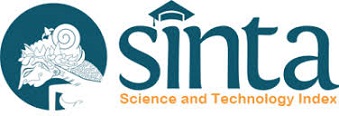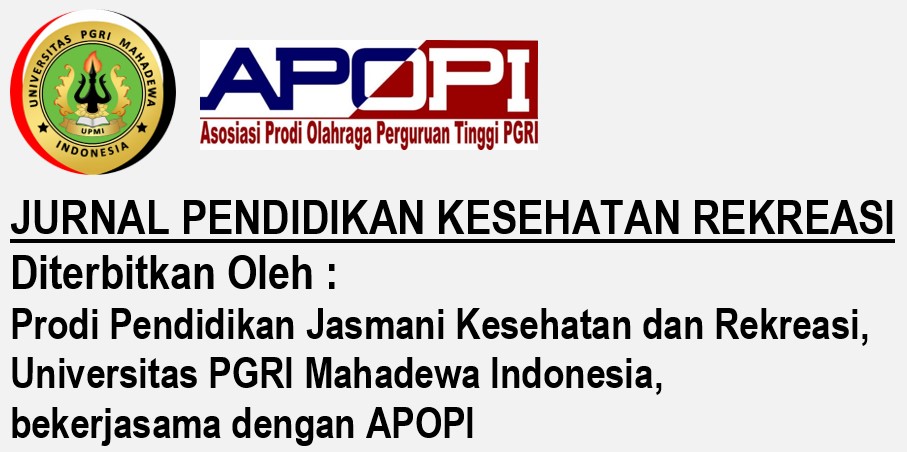Prediksi BMI Berdasarkan Level Aktivitas Fisik dengan Metode Analisis Machine Learning
DOI:
https://doi.org/10.59672/jpkr.v10i1.3499Keywords:
body mass index, physical activity, decision treeAbstract
Prevalensi obesitas telah menjadi salah satu isu global dalam bidang kesehatan di masyarakat. Sementara itu aktivitas fisik diakui menjadi salah satu yang memiliki peran penting dalam mengatasi prevalensi obesitas. Tujuan penelitian ini yaitu untuk menjelaskan hubungan aktivitas fisik dengan Body Mass Index (BMI) dengan metode ML yang saat ini tengah populer. Sumber data yang digunakan yaitu dari kelompok bidang keilmuan sport and physical activity program studi Ilmu Keolahragaan, Universitas Pendidikan Indonesia. Total 212 (usia 19-23 tahun) partisipan yang memenuhi kriteria, terlibat dalam penelitian ini. IPAQ-SF digunakan untuk memperoleh data terkait dengan aktivitas fisik partisipan. Empat metode algoritma ML yaitu decision tree, naïve bayes, k-nearest neighbors (KNN), dan random forest digunakan untuk menganalisis data. Hasil penelitian menunjukkan bahwa algoritma naive bayes memiliki performa paling unggul (akurasi = 52,38%; sensitifitas = 51,65%; spesifisitas = 53,33%) dari ketiga model ML lainnya, sementara KNN paling rendah baik akurasi, sensitifitas, maupun spesifisitas (42,86%) dalam memprediksi BMI berdasarkan level aktivitas fisik. Aktivitas fisik memiliki peran penting dalam memprediksi BMI selain faktor lainnya seperti jenis kelamin dan perilaku sedentary.
Downloads
References
Belcher, B. R., Berrigan, D., Dodd, K. W., Emken, B. A., Chou, C. P., & Spuijt-Metz, D. (2010). Physical activity in US youth: impact of race/ethnicity, age, gender, & weight status. Medicine and science in sports and exercise, 42(12), 2211.
Bolton, K., Kremer, P., Rossthorn, N., Moodie, M., Gibbs, L., Waters, E., & de Silva, A. (2014). The effect of gender and age on the association between weight status and health-related quality of life in Australian adolescents. BMC Public Health, 14, 1-8.
Cheng, X., Lin, S. Y., Liu, J., Liu, S., Zhang, J., Nie, P., Fuemmeler, B. F., Wang, Y., & Xue, H. (2021). Does physical activity predict obesity—a ML and statistical method-based analysis. International Journal of Environmental Research and Public Health, 18(8). https://doi.org/10.3390/ijerph18083966
Chin, S. H., Kahathuduwa, C. N., & Binks, M. (2016). Physical activity and obesity: what we know and what we need to know. Obesity Reviews, 17(12), 1226-1244. https://doi.org/10.1111/obr.12460
DeGregory, K. W., Kuiper, P., DeSilvio, T., Pleuss, J. D., Miller, R., Roginski, J. W., & Thomas, D. M. (2018). A review of machine learning in obesity. Obesity reviews, 19(5), 668-685. https://doi.org/10.1111/obr.12667
Dewi, N. U., Tanziha, I., & Solechah, S. A. (2020). Obesity Determinants and the Policy Implications for the Prevention and Management of Obesity in Indonesia. Current Research in Nutrition & Food Science, 8(3). https://www.researchgate.net/profile/Bohari-Bohari/publication/349044345_Obesity_Determinants_and_the_Policy_Implications_for_the_Prevention_and_Management_of_Obesity_in_Indonesia_Article_History/links/601ca71d92851c4ed54bd7ac/Obesity-Determinants-and-the-Policy-Implications-for-the-Prevention-and-Management-of-Obesity-in-Indonesia-Article-History.pdf
Dwyer-Lindgren, L., Freedman, G., Engell, R. E., Fleming, T. D., Lim, S. S., Murray, C. J., & Mokdad, A. H. (2013). Prevalence of physical activity and obesity in US counties, 2001–2011: a road map for action. Population health metrics, 11(1), 1-11. https://doi.org/10.1186/1478-7954-11-7
Ellis, K., Godbole, S., Marshall, S., Lanckriet, G., Staudenmayer, J., & Kerr, J. (2014). Identifying active travel behaviors in challenging environments using GPS, accelerometers, and ML algorithms. Frontiers in Public Health, 2(APR), 1–8. https://doi.org/10.3389/fpubh.2014.00036
Fitri, Y., Mulyani, N. S., Fitrianingsih, E., & Suryana, S. (2016). Pengaruh pemberian aktifitas fisik (aerobic exercise) terhadap tekanan darah, IMT dan RLPP pada wanita obesitas. AcTion: Aceh Nutrition Journal, 1(2), 105-110. DOI : 10.30867/action.v1i2.19
Fogelholm, M., & Kukkonen‐Harjula, K. (2000). Does physical activity prevent weight gain–a systematic review. Obesity reviews, 1(2), 95-111.
Goodwin, P. J., & Stambolic, V. (2015). Impact of the obesity epidemic on cancer. Annual review of medicine, 66, 281-296. https://doi.org/10.1146/annurev-med-051613-012328
Huang, C. J., McAllister, M. J., Slusher, A. L., Webb, H. E., Mock, J. T., & Acevedo, E. O. (2015). Obesity-related oxidative stress: the impact of physical activity and diet manipulation. Sports medicine-open, 1, 1-12. https://doi.org/10.1186/s40798-015-0031-y
Jajat, J., & Suherman, A. (2020). Indonesian Children and Adolescents’ Body Mass Index: WHO and Asia-Pacific Classification. In 4th International Conference on Sport Science, Health, and Physical Education (ICSSHPE 2019) (pp. 263-266). Atlantis Press
Lim, J. U., Lee, J. H., Kim, J. S., Hwang, Y. I., Kim, T. H., Lim, S. Y., & Rhee, C. K. (2017). Comparison of World Health Organization and Asia-Pacific body mass index classifications in COPD patients. International journal of chronic obstructive pulmonary disease, 2465-2475
Milita, F., Handayani, S., & Setiaji, B. (2021). Kejadian diabetes mellitus tipe II pada lanjut usia di Indonesia (analisis riskesdas 2018). Jurnal Kedokteran Dan Kesehatan, 17(1), 9-20. https://doi.org/10.24853/jkk.17.1.9-20
Murdoch, W. J., Singh, C., Kumbier, K., Abbasi-Asl, R., & Yu, B. (2019). Definitions, methods, and applications in interpretable machine learning. Proceedings of the National Academy of Sciences, 116(44), 22071-22080. https://doi.org/10.1073/pnas.1900654116
Nilashi, M., bin Ibrahim, O., Ahmadi, H., & Shahmoradi, L. (2017). An analytical method for diseases prediction using machine learning techniques. Computers & Chemical Engineering, 106, 212-223. https://doi.org/10.1016/j.compchemeng.2017.06.011
Nurcahyo, F. (2011). Kaitan antara obesitas dan aktivitas fisik. Medikora, (1). DOI:10.21831/medikora.v0i1.4663
Parinduri, F. K., Djokosujono, K., & Parinduri, S. K. (2021). Faktor Dominan Obesitas Sentral pada Usia 40-60 tahun di Indonesia (Analisis Data Indonesian Family Life Survey 5 Tahun 2014/2015). HEARTY: Jurnal Kesehatan Masyarakat, 9(2), 58-70. https://doi.org/10.32832/hearty.v9i2.5397
Rachmi, C. N., Li, M., & Baur, L. A. (2017). Overweight and obesity in Indonesia: prevalence and risk factors—a literature review. Public health, 147, 20-29. https://doi.org/10.1016/j.puhe.2017.02.002
Rousset, S., Angelo, A., Hamadouche, T., & Lacomme, P. (2023). Weight Status Prediction Using a Neuron Network Based on Individual and Behavioral Data. In Healthcare (Vol. 11, No. 8, p. 1101). MDPI
Suwandaru, C., Hidayat S-, T., Rekreasi, dan, & Ilmu Olahraga, F. (2021). Hubungan Aktivitas Fisik dengan Prestasi Belajar Siswa SMK Negeri 1 Surabaya. https://ejournal.unesa.ac.id/index.php/jurnal-pendidikan-jasmani
Swift, D. L., McGee, J. E., Earnest, C. P., Carlisle, E., Nygard, M., & Johannsen, N. M. (2018). The effects of exercise and physical activity on weight loss and maintenance. Progress in cardiovascular diseases, 61(2), 206-213
Villasana, M. V., Pires, I. M., Sá, J., Garcia, N. M., Zdravevski, E., Chorbev, I., & Flórez-Revuelta, F. (2020). Promotion of healthy nutrition and physical activity lifestyles for teenagers: A systematic literature review of the current methodologies. Journal of personalized medicine, 10(1), 12. https://doi.org/10.3390/jpm10010012
Visscher, T. L., & Seidell, J. C. (2001). The public health impact of obesity. Annual review of public health, 22(1), 355-375. https://doi.org/10.1146/annurev.publhealth.22.1.355
Wyatt, S. B., Winters, K. P., & Dubbert, P. M. (2006). Overweight and obesity: prevalence, consequences, and causes of a growing public health problem. The American journal of the medical sciences, 331(4), 166-174. https://doi.org/10.1097/00000441-200604000-00002
Xue, Q., Wang, X., Meehan, S., Kuang, J., Gao, J. A., & Chuah, M. C. (2018, December). Recurrent neural networks based obesity status prediction using activity data. In 2018 17th IEEE International Conference on ML and Applications (ICMLA) (pp. 865-870). IEEE
Zeng, G. (2020). On the confusion matrix in credit scoring and its analytical properties. Communications in Statistics-Theory and Methods, 49(9), 2080-2093
Downloads
Published
How to Cite
Issue
Section
License
Copyright (c) 2024 Diki Saputra Saputra, Jajat, Imas Damayanti, Kuston Sultoni, Yati Ruhayati, Nur Indri Rahayu

This work is licensed under a Creative Commons Attribution-NonCommercial-ShareAlike 4.0 International License.
Jurnal Pendidikan Kesehatan Rekreasi is published under the terms of Creative Commons Attribution 4.0 International License / CC BY NC SA 4.0. This license permits others to copy, distribute, modify, and create derivative works for non-commercial purposes only


































